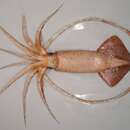fi
nimet breadcrumb-navigoinnissa


Onykia ingens, the greater hooked squid, is a species of squid in the family Onychoteuthidae. It occurs worldwide in subantarctic oceans.
Although O. ingens was long attributed to the genus Moroteuthis, several authors have recently agreed that Moroteuthis is a junior synonym of Onykia.[3]

The size of a fully grown O. ingens, inclusive of tentacles, is currently unknown. Many estimates, however, predict that the mantle may reach lengths of up to 94 cm (37 in). Research has found that egg sizes of the squid average 2.1 mm inside mature females, while juveniles average 4.6 mm or larger. Juveniles are presumed to live near the surface, until they reach a mantle length of approximately 200 mm, at which time they relocate to deeper water, and larger prey. O. ingens exhibit sexual dimorphism, with females growing linearly twice as fast as males, and reaching a fully mature size of more than five times that of male counterparts.[4]
Penis elongation has been observed in this species; when erect, the penis may be as long as the mantle, head and arms combined.[5][6] As such, deep water squid like M. ingens have the greatest known penis length relative to body size of all mobile animals, second in the entire animal kingdom only to certain sessile barnacles.[5]
It is generally accepted that there are large dietary variations between large and small O. ingens. One of the most common findings is that juvenile squid (>200 mm ML) consume a greater percentage of crustaceans and cephalopods compared to their size than mature squid, which consume a large percentage of fish and virtually no crustaceans.[7] Globally, however, myctophid fish (lantern fish) are seen as common prey.[8] Larger squid are known to practice cannibalism (accounting for up to 6% of diet).[9]
O. ingens, as with many (if not all) large squid, has a number of predators. These include the patagonian toothfish, king penguin, wandering albatross, pilot whale, bottlenose whale, dwarf sperm whale, sperm whale, and other types of squid.[10] Other predators include Antarctic and Subantarctic fur seals.
Gladius with cross-sections
Onykia ingens, the greater hooked squid, is a species of squid in the family Onychoteuthidae. It occurs worldwide in subantarctic oceans.
Although O. ingens was long attributed to the genus Moroteuthis, several authors have recently agreed that Moroteuthis is a junior synonym of Onykia.
Onykia ingens est une espèce de calmar de la famille des onychoteuthidés vivant dans l'océan austral. Bien que O. ingens a longtemps été placé dans le genre Moroteuthis, plusieurs auteurs ont récemment convenu que Moroteuthis est un synonyme d'Onykia.
La taille maximale d'O. ingens, y compris les tentacules, est actuellement inconnue. De nombreuses estimations, toutefois, suggèrent que le manteau peut atteindre des longueurs allant jusqu'à 94 cm. La taille des œufs atteint en moyenne de 2,1 mm à l'intérieur des femelles matures, tandis que les juvéniles mesurent en moyenne 4,6 mm ou plus. Les jeunes vivent près de la surface, jusqu'à ce qu'ils atteignent une longueur du manteau d'environ 200 mm, taille à laquelle ils descendent vivre dans des eaux plus profondes et pour attraper de plus grosses proies. O. ingens présente un dimorphisme sexuel, les femelles de grandissent deux fois plus vite linéairement que les mâles, et atteingnent une taille à maturité plus de cinq fois supérieure à celle de leurs homologues masculins.
Un allongement du pénis a été observé chez Onykia ingens ; en érection, le pénis peut être aussi long que le manteau, la tête et les bras. Ainsi, il possède le plus grand pénis par rapport à la taille du corps de tous les animaux mobiles, les deuxièmes du règne animal après certains cirripèdes [1].
Onykia ingens est une espèce de calmar de la famille des onychoteuthidés vivant dans l'océan austral. Bien que O. ingens a longtemps été placé dans le genre Moroteuthis, plusieurs auteurs ont récemment convenu que Moroteuthis est un synonyme d'Onykia.